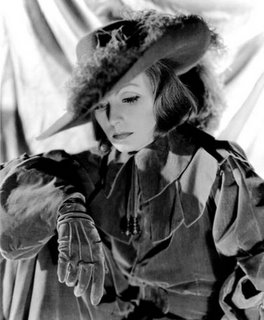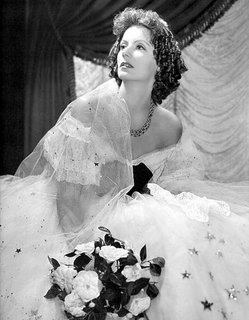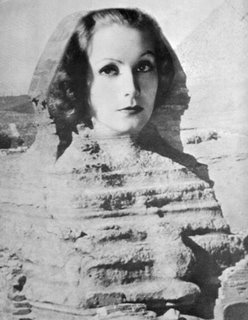
by Nick Zegarac
She was a legend in her own time, destined for immortality even before her stay on earth had ended. Today, the name Garbo continues to conjure that essence of a most elusive, enigmatic and mysterious woman – an androgynous, near mythological creature at odds with her own image and generation. Despite her filmic testaments that radiate a genuine luminosity and seemingly endless well of emotions on the silver screen, in life Greta Garbo was a very real, very problematic personality, often mired by inner contradictions that frequently made her unable to experience friendship or sacrifice anything for even those who were closest to her.
So completely removed from her own time and lost in the world around her, at the age of 36 Garbo fled into self-imposed exile from both the spotlight and the millions of adoring fans who had helped make her success. At the very zenith of her fame, she denied the world her presence – a move scrutinized by critics but one that made her all the more fascinating to her admirers.

She was born Greta Gustafsson in Stockholm Sweden on September 18, 1905. An amiable, charming, slightly fattish girl of working class parents who lived in a tenement at Blekingegatan 32, Garbo’s youth was spent attending Katarina Sodra Primary School. By all accounts she was a well-behaved mature and diligent pupil. Garbo also became fascinated with the theater and silent cinema in particular; her favorite actress - America’s sweetheart: Mary Pickford. At 15, Garbo joined the prestigious Royal Dramatic Academy, confiding her greatest personal insecurity to a close friend and fellow student. “I’m horribly uncultured.”
But by 1920, Garbo had taken her first unlikely step toward stardom, appearing as a fashion model in a catalogue for PUB, a reputable department store. She also appeared in a film commercial for that establishment. It brought her to the attention of Swedish film director, Mauritz Stiller. Already reputed as a genius, Stiller’s approach to molding Gustafsson into his vision of a great actress began with a strict regiment of exercise and diet to rid her excess weight. It also included a name change – from Gustafsson to Garbo. Today, the origins of that alteration remain as mysterious as the lady herself, though some have speculated that the moniker derived from Erica Darbo – a then popular Norwegian operetta star.
Newly rechristened, Garbo appeared for Stiller in Gosta Berling’s Saga (1924) a silent melodrama based on Selma Lagerlof’s popular novel. By now, director and star were lovers and Stiller’s romantic fascination with his young protégée grew into a highly protective shell. Though the reviews Garbo received from her Swedish critics were unanimously harsh, outside interests generated by the film were favorable to very good. Garbo next appeared in The Streets of Sorrow (1925), shot in Berlin for German director, G.W. Pabst.
It was at this junction in Garbo’s early career that Stiller was offered a contract in Hollywood by L.B. Mayer, then head of the newly amalgamated Metro-Goldwyn-Mayer Studios. Despite a lack of interest in Garbo as a saleable commodity, Mayer reluctantly agreed to import the actress along with her mentor. The two arrived in New York in July 1925 for what regrettably developed into a lengthy fallow period in both their careers. Upon departing the ship, Stiller was shocked to discover that only a single photographer had been assigned to immortalize the occasion. MGM was in a state of chaos and quite unequipped to provide the sort of fanfare either Stiller or Garbo had expected.

Despite this early setback, Garbo and Stiller’s next reception in Los Angeles proved more inviting, with a select cast of Swedish immigrants (most of whom worked at the studio) cheering and offering flowers as they stepped from the train. L.B. Mayer however, was unimpressed by what he deemed an awkward peasant girl. “Americans don’t like their women fat,” he reportedly told Garbo, “…and get your teeth fixed.”
As Garbo and Stiller lay dormant on the studio’s roster of things to do, Stiller became increasingly impatient. For Garbo, this waiting period only served to put her own insecurities more ill at ease. She found the vast and sprawling acreage of MGM foreboding, cold and monolithic. The studio system – then in its infancy – frightened her. “I have become afraid of life” she wrote in a letter home, “It’s as if someone has cut off part of me. I’ve tried to get permission to go home but everyone advises me not to.”
Mayer’s early involvement in Garbo’s career did little to ease her apprehensions. Unable to get a pulse on how best to exploit his new starlet, MGM’s publicity department attempted to fabricate an athletic persona for her by photographing Garbo with male athletes from the University of Southern California and even Leo, the MGM lion. Though Mayer assigned two of the studio’s premiere cameramen, William Daniels and Hendrik Sartov, to lens her screen tests, after much prodding it was Stiller who secured Garbo her American debut in The Torrent (1925) though his involvement with the film ended there.
Groomed as the next vamp, Garbo nevertheless managed to transcend the limitations of that stereotype and infuse her character with an ambiguous sexuality that was both feminine yet highly assertive. Directed by Monta Bell, The Torrent radiated eroticism unlike any seen on the screen. It was an instant success.
Mayer, a highly righteous individual who frequently did much of his reasoning with a pair of fists, did not particularly mind a little naughtiness for the camera. But he did abhor the thought of Garbo (whom he now deemed as his discovery) living in sin with Stiller. Reluctantly, Mayer purchased the home that Garbo and Stiller shared on the coast, a lavish bungalow with secret passages designed to conceal their illicit romance from prying eyes.
As for Stiller, his popularity at the studio had quickly begun to cool. Frequently misunderstood and in conflict with his superiors at MGM, Stiller was first assigned to, then removed from, Garbo’s next project, The Temptress (1925). Stiller left MGM in 1927, frustrated, tired and with his reputation as a brilliant director dismantled. He would die one year later.
By the summer of 1926, Garbo was already a minor fascination amongst the international elite, thanks to her latest assignment, Flesh and the Devil which teamed her with two of her greatest co-collaborators; director Clarence Brown and matinee idol John Gilbert. “I never directed Garbo in anything above a whisper,” Brown later explained in an interview, confiding that he was never quite satisfied with her understated performance until he saw the film rushes, “…but there was something behind the eye that told the whole story.”
Indeed, Garbo and Gilbert’s love scenes smoldered on camera, primarily because the two had become intimate behind the scenes. However, when Gilbert jumped the gun, announcing to all that he would marry Garbo – only to have the bride not show up at the reception – his humiliation as a romantic leading man became complete. “Sleep with her,” Mayer reportedly told Gilbert, “But don’t marry her.”

At the behest of studio publicity, Garbo dined with Sweden’s Crown Prince Gustaf Adolf and Princess Louise while on their American goodwill tour, later musing, “I arrived 15 minutes late…wasn’t my fault that I worked – a scandal! He (the prince) was very friendly and I poured out all sorts of foolish things.” Yet, in retrospect, Garbo’s complicity in attending this dinner for the purposes of self and studio promotion seems off kilter with her more usual reservations about indulging in what she considered utter nonsense.
Indeed, when Mayer ordered Garbo (along with every other star under his tutelage) to attend his 4th of July birthday party, she quietly ignored the ‘invitation’ and remained absent from the event. Her frequent noncompliance to such seemingly harmless and casual requests was eventually threatened with deportation. Possessing a strong will, Garbo instead chose to go on strike and even agreed to being deported. Her timing was perfect. By 1928, the box office grosses from her films accounted for roughly 12% of the studio’s total profits. She was too hot a property to discard in haste and she knew it.

However, the biggest question concerning Garbo in 1929 was not how far she would allow the studio to push her vibrant independence, but whether or not she could talk. Sound recording had rendered most of the studio’s roster of European talent mute – their thick awkward accents speaking fractured English had become the cornerstone of much consternation and considerable loss of studio revenues.
Though MGM tested the viability of virtually all of their stars, except Garbo, in 1929’s talkie The Hollywood Revue, after much reluctance and planning, V.P. in charge of production – Irving Thalberg, chose Eugene O’Neill’s Anna Christie (1930) as Garbo’s sound debut. The seedy waterfront melodrama proved an ideal springboard for Garbo’s low husky voice and the public – who had thus far embraced her as their own – now fell into an immediate fit of mass hysteria.
Calculating her every career move, Garbo relied on Irving Thalberg’s judgment to secure her prominent roles. In 1932’s all-star Grand Hotel, she was cast as a temperamental ballerina whose ill-fated love affair with a baron (John Barrymore) ends in his death. Initially, Garbo had expressed misgivings about costarring opposite Barrymore (whom she regarded as a far greater talent than her own) – apprehensions that were reciprocated by Barrymore (who had heard through the grapevine that Garbo was difficult to work with). One day, the two met off camera to get acquainted before shooting on the project began. They instantly became the best of friends and ardent admirers of one another’s talents. Garbo would later tell Barrymore, “You have no idea what it means to me to play opposite so perfect an artist.”
What was becoming increasingly problematic for Garbo during this period was her inability to take a firm grasp of her own stardom. Fame frightened her. Her reclusive nature and refusal to give interviews or sign autographs had ignited a nationwide fervor to get closer to her. Papers and magazines of the day reported that a Midwestern farmer had died and left Garbo his entire fortune. It was also claimed that a young girl had thrown herself in front of Garbo’s moving car in a fit of passion, declaring “I love you.” Frantic for some sort of semblance, Garbo departed for Sweden, a move that only served to stir more erroneous speculations. Had she retired? Was she going to marry a prince? Why did she want to be “left alone?”

By now, MGM had renegotiated her contract and Garbo returned to the studio to film Queen Christina (1934), by far her most androgynous role. In it, Garbo’s character is propositioned by a young maiden (who thinks her a man and a commoner) while staying at a country inn. The queen also refuses to marry the man the state has chosen for her, declaring to her ambassadors “I have no intention of dying an old maid…I shall die a bachelor.” At one point, Garbo’s queen even expresses overt jealousy over her lady in waiting, whom she has kissed on the lips.
In retrospect, it is primarily for this role – and Garbo’s ability throughout her career to poke fun at her own sexuality when pressed on the point - that has made some film scholars since her time appropriate the Garbo mystique to lesbian and bisexual literature. However, such misappropriation is purely speculative – since Garbo’s list of lovers in life is exclusively populated by men (Stiller, Gilbert and conductor, Leopold Stokowski).
While the public of its day relished Queen Christina, Joseph Breen and the Censorship Offices were shocked and appalled by the aforementioned transgressions. MGM was ordered to trim the film but miraculously declined and released it in its entirety – the last time they would be afforded such a luxury. By 1935, the code had tightened its strictures on all films produced under the studio system.
Hence, Garbo’s next film, Anna Karenina (1935), a remake of Love (1927) was a highly sanitized adaptation of Leo Tolstoy’s passionate novel. 1937’s Camille pursued the image of Garbo as a great tragic actress. The film proved popular with audiences and critics alike. As the doomed courtesan Maurgurite Gautier, Garbo’s technical proficiency infused a subtle hint of delicate perversity and dramatic irony into the role. Women championed her performance as redefining femininity. Men in general, however, were remote over her more masculine stance.

Garbo had become too highbrow and cultured. Though her films continued to be wildly popular in Europe, in America she was considered something of an embarrassment that went against the grain of that more popular trend for brash and buxom leading ladies. A scathing article in Daily Variety proclaimed her box office poison.
As a last ditch effort to resurrect her waning popularity, MGM launched Garbo in her only comedy, the effervescent Ninotchka (1939) directed by Ernest Lubitsch. Cast as a Russian commissar who is assigned to secure her three comrades from the wiles of decadent Paris, Garbo managed to poke fun and irony at many of her own highfaluting airs. The film’s overwhelming success seemed to guarantee another project with Lubitsch. But instead, MGM miscast Garbo in Two-Faced Woman (1940) a horrific debacle in which she played twin sisters.
Upon its release, one critic remarked, “It’s as shocking as seeing your mother drunk!” Indeed, the pendulum in her career had swung too far in the other direction. Garbo, who had never known professional failure, quietly
 approached Mayer to ask for a release from her contract. Possibly she was conscious of the fact that with World War II raging overseas, the bulk of revenue from whatever future projects the studio had planned for her (which had always come from the European market) had been thwarted. But there also remains the very real possibility that Garbo was genuinely tired of Hollywood itself and the adulation that had made her a prisoner of her own popularity.
approached Mayer to ask for a release from her contract. Possibly she was conscious of the fact that with World War II raging overseas, the bulk of revenue from whatever future projects the studio had planned for her (which had always come from the European market) had been thwarted. But there also remains the very real possibility that Garbo was genuinely tired of Hollywood itself and the adulation that had made her a prisoner of her own popularity.Whatever the case, Garbo left MGM after Two-Faced Woman for what was then referred to as 'an extended stay.' She never returned.
Though frequently given proposals for films throughout the forties Garbo turned down virtually every project. In 1949, she reluctantly agreed to screen test for Walter Wanger in what remains the last appearance of Garbo on celluloid. Exuding the radiance and magic she had cultivated as her hallmark nearly a decade before, the return of Garbo to films seemed a foregone conclusion. But the undisclosed project ran into financial difficulties that deeply saddened the actress and eventually caused her to withdraw for the last time. “I realized I didn’t matter anymore,” she later commented, “They couldn’t get enough money because it was Garbo.”
Installed in her fashionable New York apartment, Garbo’s final decades were affectionate dubbed as “the recluse about town.” For although she continued to profess a loathsome rejection of publicity, Garbo almost daily went for long walks about Manhattan, frequenting shops, sometimes with walking companion, Sam Green who had never seen a Garbo movie prior to befriending the actress.
In 1954, the Academy of Motion Picture Arts and Sciences did get around to bestowing an honorary Oscar for her body of work, but Garbo was not on hand to personally accept this award. Instead, she lived a life apart from her past, indulging in a bit of gardening when she felt like it, and, collecting rare art simply on the basis of what she found personally agreeable to her home décor. In 1990,
 after penning her biography, the denial of her own fame was made complete when Greta Garbo quietly died of natural causes at the age of 84.
after penning her biography, the denial of her own fame was made complete when Greta Garbo quietly died of natural causes at the age of 84.Today, it seems unfathomable that Garbo ever really existed. For any retrospective of her filmic work tends to conjure up more questions than answers about what Garbo was genuinely like behind that fabricated façade. What is revealed about the woman is a haunting – perhaps haunted - tragic and sad beauty to which some deep seeded secret longings, desires and passions are only glimpsed at from behind her guarded soul. Garbo is indeed, as one clever artist so accurately depicted her at the height of her popularity; the Sphinx of the 20th century. She is like Chaplin – man, woman and child all rolled into one; an enigma that remains profoundly elusive in her ability to maintain that mystery so desperately desiring to be ‘left alone.’
@Nick Zegarac 2006 (all rights reserved).
No comments:
Post a Comment